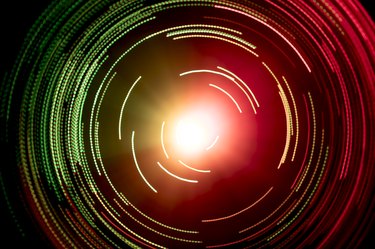
Things You'll Need
Soldering iron
Replacement LED bulbs
If you've tried to use your LED light circuit and found that it's not working correctly, doing some basic repair is a great way to save on buying a new circuit altogether. LED lights are used for many things, such as Christmas lights, clock displays and power indicators, and knowing how to repair them can be a valuable skill. It helps to have a general knowledge of electrical circuits, but even without background knowledge, it is easy to fix your LED lights in time for Christmas.
Step 1: Identify the LD Light That Doesn't Work
Identify broken LEDs. You can do this easily by powering up your circuit and seeing which bulbs don't light. Generally, replacing faulty bulbs will solve issues with LED circuits and fix broken LED lights. Depending on your circuit, you will need to connect the battery or plug it in. If the entire circuit isn't lighting up, there could be a problem with your power source.
Video of the Day
Step 2: Remove the Broken LEDs
Remove the broken LEDs. You may need a soldering iron to do this, depending on how the LEDs are connected to the wire. In commercial LED light circuits, there may be sockets for each individual lamp, and you can simply pull them out. Note the polarity of the LEDs you remove. The polarity is determined by the differing lengths of the connectors coming from the base of the bulb. The shorter wire is the cathode, the negative charge. Remember which side this is on; the socket should be cut to suit the differing lengths.
Step 3: Replace the LEDs
Replace the LEDs with lights of similar voltage. LEDs do not need to be matched in voltage by a common and exact resistance value, just a general one. This makes replacing bulbs easier, because you can identify suitable LEDs by their color. There are two general groups of LED light voltage: those around 3.2V are white, blue or green, and those around 2V are red, orange or yellow. Your LED circuit is liable to be made up of one of those groups of colors.
Step 4: Connect Replacement Lamps
Connect your replacement lights as needed. This can differ across types of circuit, and if you've got a set of Christmas lights, the sockets may have varying designs, and your new bulb connectors may have to be bent or otherwise cajoled into the correct shape in order to fix your LED lights. This may seem a somewhat brutal solution to a delicate problem, but there is no electrical difference in these sockets, only a cosmetic one.
Step 5: Finish the Fix for Your LED Lights
Check the socket's polarity if a bulb still doesn't work. In some circuits, a socket might be the wrong way around, so even a new bulb won't work. Sockets are made to fit the longer positive connector and the shorter cathode. Across a circuit, the sockets should all be aligned in the same direction. If they are not, you can fix the problem. Disconnect the wire from either side of the reversed socket (with a soldering iron, if necessary). Turn it around, and reconnect the wires. The polarity of the socket should now match the rest of the ones in the LED circuit, and the bulb should light.
Video of the Day